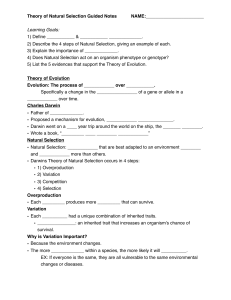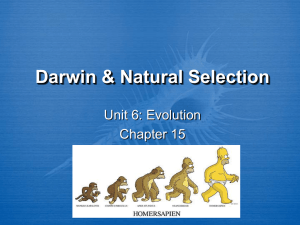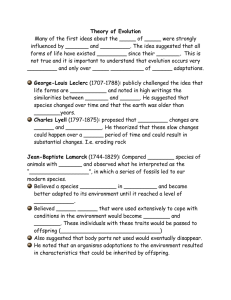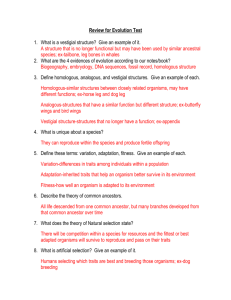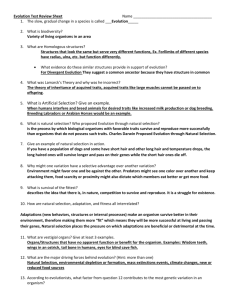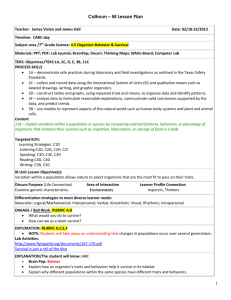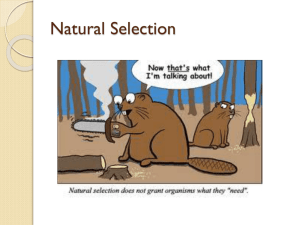Darwin & Natural Selection Unit 10 Evolution
advertisement
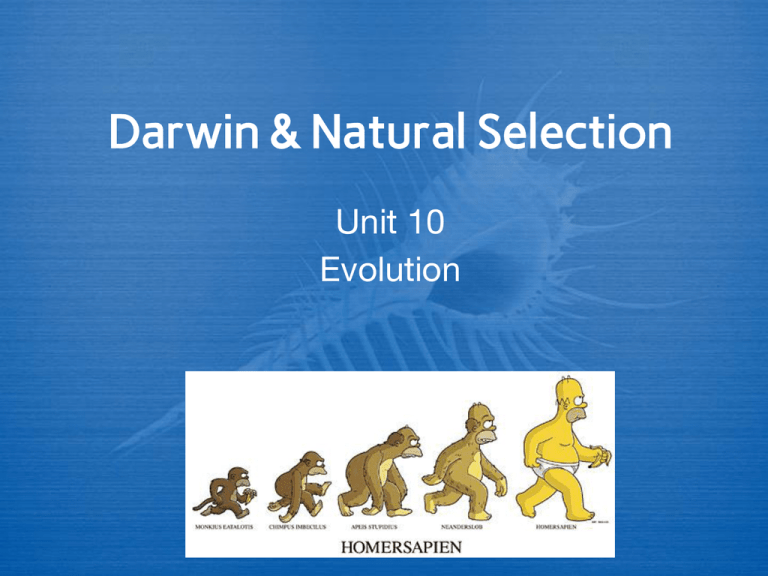
Darwin & Natural Selection Unit 10 Evolution Learning Goals ▪ 1. Define "Evolution" & "Natural Selection". ▪ 2. Describe the 5 steps of Natural Selection, giving an example of each. ▪ 3. Explain the importance of "Variation". ▪ 4. Does Natural Selection act on an organism phenotype or genotoype? Explain! ▪ 5. List the 5 evidences that support the Theory of Evolution. Theory of Evolution ▪ Evolution: The process of change over time • Specifically, a change in the frequency of a gene or allele in a population over time Charles Darwin ▪ Father of Evolution ▪ Proposed a mechanism for evolution, natural selection ▪ Darwin went on a 5-year trip around the world on the ship, the HMS Beagle • As the ship’s naturalist, he made observations of organisms in South America and the Galapagos Islands •Wrote a book, “Origin of the Species” Darwin’s Finches Natural Selection ▪ Natural Selection: Organisms that are best adapted to an environment survive and reproduce more than others ▪ Darwin’s Theory of Natural Selection occurs in five steps: • Variation exists within a population • Some variations favor survival of an organism • Overpopulation leads to competition • Survivors may pass down favorable traits • Long periods of time allow for small changes to accumulate & contribute to survival adaptations 1. Variation ▪ Each individual has a unique combination of inherited traits. ▪ Adaptation: an inherited trait that increases an organism’s chances of survival ▪ 2. Some variations favor the survival of an organism What adaptations do you see? What adaptations do you see? Why is Variation Important? ▪ Because the environment changes. ▪ The more variation within a species, the more likely it will survive • EX: If everyone is the same, they are all vulnerable to the same environmental changes or diseases ▪ The more variation of types of species in an habitat, the more likely at least some will survive • EX: Dinosaurs replaced by mammals Which community has a better chance of surviving a natural disaster? Community A Community B 3. Overpopulation leads to Competition ▪ Each species produces more offspring that can survive 3. Competition ▪ Individuals COMPETE for limited resources: • Food, water, space, mates ▪ Natural selection occurs through “Survival of the fittest” ▪ Fitness: the ability to survive and reproduce ▪ Not all individuals survive to adulthood 4. Survivors may pass down favorable traits ▪ The individuals with the best traits / adaptations will survive and have the opportunity to pass on it’s traits to offspring. • Natural selection acts on the phenotype (physical appearance), not the genotype (genetic makeup) • Ex: When a predator finds its prey, it is due to the prey’s physical characteristics, like color or slow speed, not the alleles (BB, Bb) 5. Long periods of time lead to small changes in a population ▪ Individuals with traits that are not well suited to their environment either die or leave few offspring. ▪ Evolution occurs when good traits build up in a population over many generations and bad traits are eliminated by the death of the individuals. Peppered Moth A ▪ Which moth will the bird catch? B Descent with Modification ▪ Descent with Modification – each living species has descended, with changes, from other species over time. ▪ Common Descent – all living organisms are related to one another Evidence for Evolution: ▪ ▪ ▪ ▪ ▪ Fossil Record Homologous Body Structures Vestigial Organs Embryology Biochemical Evidence The Fossil Record ▪ Fossils: a record of the history of life on Earth Archaeopteryx ▪ Missing link between reptiles and birds Homologous Body Structures ▪ Homologous Body Structures: similar anatomy in different types of animals because of common ancestor Vestigial Organs • Vestigial Organs: “leftover” traces of evolution that serve no purpose Embryology ▪ Embryology: embryos of all vertebrates are very similar early on Biochemical Evidence ▪ Biochemistry: DNA with more similar sequences suggest species are more closely related • EX: Humans and chimpanzees share more than 98% of identical DNA sequences Learning Goals ▪ 1. Define "Evolution" & "Natural Selection". ▪ 2. Describe the 5 steps of Natural Selection, giving an example of each. ▪ 3. Explain the importance of "Variation". ▪ 4. Does Natural Selection act on an organism phenotype or genotoype? Explain! ▪ 5. List the 5 evidences that support the Theory of Evolution. Coral Snake (Poisonous) Milk Snake (Not poisonous) Stick Mantid Flower Mantid
